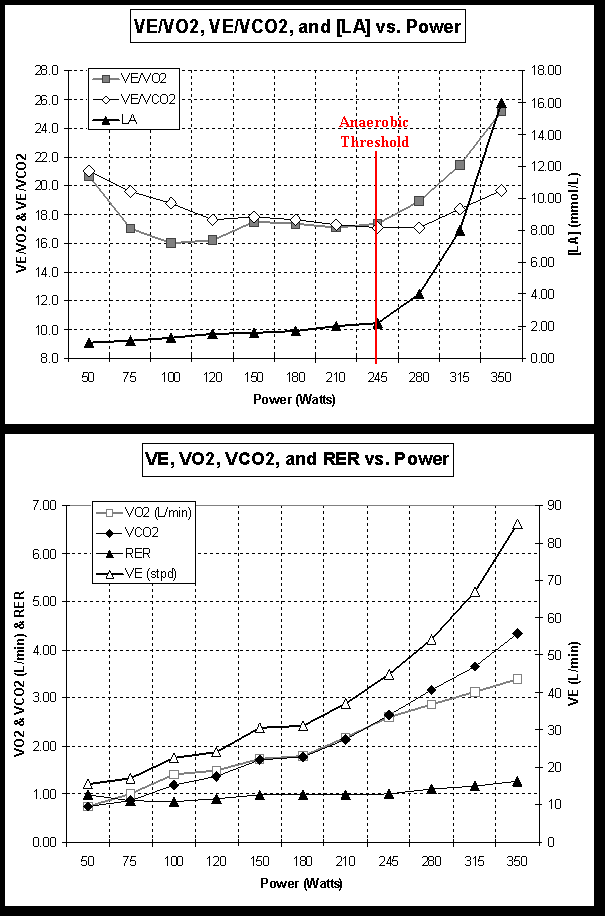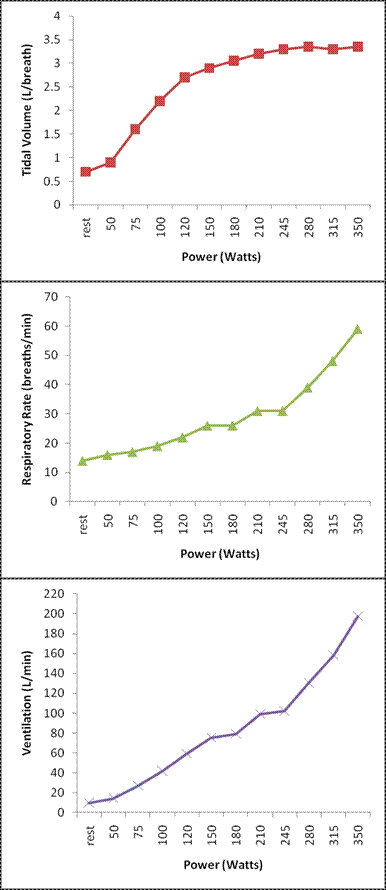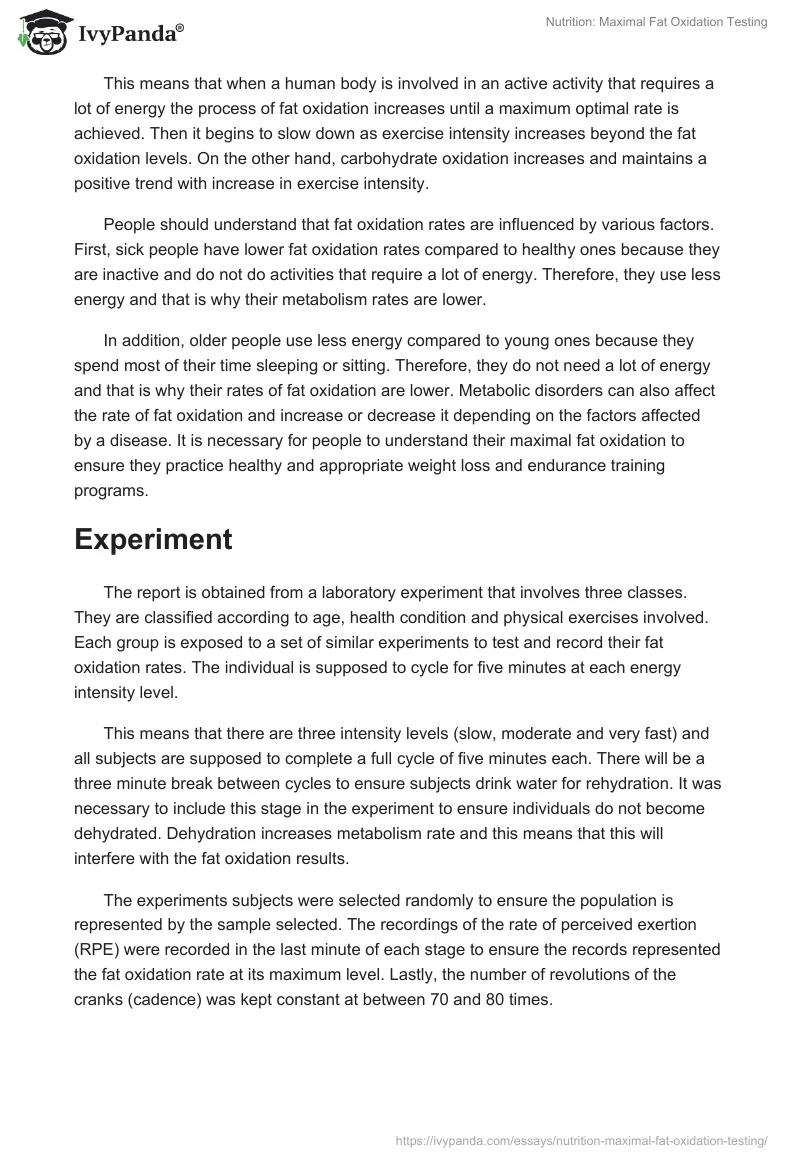Introduction
The human body requires energy to be used for various activities. Different amounts of energy are required by various activities in the body depending on their intensity, frequency and duration.
For instance, the rates of metabolism in men and women are not similar because they have different physiological characteristics. Women produce and use more energy than men and this means that their metabolism rate must be faster and higher. This discussion examines fat oxidation rates and presents various approaches used to calculate energy requirement values.
Background
People developed obesity when there is a reduced exercise maximal fat oxidation. Their bodies produce a lot of energy that is unused; therefore, it is stored as fats under the skin and this causes abnormal increase in weight. Other people have energy oxidation problems and this causes an increase in body weight even if they exercise regularly.
This lab report will examine the various processes involved in fat oxidation and use the gold standard test to determine the work rate at which a subject reaches the maximum rate. The report is informed by the fact that the optimization of fat metabolism is an important process that helps the body to perform its work properly and enables people to stay healthy.
It is important to understand that fat oxidation rates vary depending on various factors. This rate increases and decreases depending on factors that affect metabolism and respiration. In addition, issues like high exercise intensity affect the rate of fat oxidation while carbohydrate oxidation rate has a direct proportional relation with increase in exercise intensity.
This means that when a human body is involved in an active activity that requires a lot of energy the process of fat oxidation increases until a maximum optimal rate is achieved. Then it begins to slow down as exercise intensity increases beyond the fat oxidation levels. On the other hand, carbohydrate oxidation increases and maintains a positive trend with increase in exercise intensity.
People should understand that fat oxidation rates are influenced by various factors. First, sick people have lower fat oxidation rates compared to healthy ones because they are inactive and do not do activities that require a lot of energy. Therefore, they use less energy and that is why their metabolism rates are lower.
In addition, older people use less energy compared to young ones because they spend most of their time sleeping or sitting. Therefore, they do not need a lot of energy and that is why their rates of fat oxidation are lower. Metabolic disorders can also affect the rate of fat oxidation and increase or decrease it depending on the factors affected by a disease. It is necessary for people to understand their maximal fat oxidation to ensure they practice healthy and appropriate weight loss and endurance training programs.
Experiment
The report is obtained from a laboratory experiment that involves three classes. They are classified according to age, health condition and physical exercises involved. Each group is exposed to a set of similar experiments to test and record their fat oxidation rates. The individual is supposed to cycle for five minutes at each energy intensity level.
This means that there are three intensity levels (slow, moderate and very fast) and all subjects are supposed to complete a full cycle of five minutes each. There will be a three minute break between cycles to ensure subjects drink water for rehydration. It was necessary to include this stage in the experiment to ensure individuals do not become dehydrated. Dehydration increases metabolism rate and this means that this will interfere with the fat oxidation results.
The experiments subjects were selected randomly to ensure the population is represented by the sample selected. The recordings of the rate of perceived exertion (RPE) were recorded in the last minute of each stage to ensure the records represented the fat oxidation rate at its maximum level. Lastly, the number of revolutions of the cranks (cadence) was kept constant at between 70 and 80 times.
Calculations
Estimated Maximal power
This figure is arrived at by subtracting the volume of carbon dioxide produced when an individual is not cycling (normal fat oxidation) from the amount of carbon dioxide produced when the body is exposed to high exercise intensity. The maximal power of a 20 year old can be calculated as follows.
Work rate= (Peak VO2 ml/min – VO2 unloaded ml/min)/10
Peak VO2= 190-20=170 x 20= 3400
VO2 Unloaded= 150+ (6 x 87) =672
Maxpower= 3400-672/10= 272.8=273
However, this value (273) should be increased by 20% because this is an oxidation rate for an energetic person. The figure would have remained the same if it were for old or sedentary people. It is necessary to explain that most people aged between 15 and 35 are very energetic. Therefore, their bodies are used to energy intensive activities and that is why their fat oxidation rates are usually higher and they reach the optimum level quickly.
Calculations for 30, 40, 50, 60 and 70% Powers
Work rate= (Peak VO2 ml/min – VO2 unloaded ml/min)/10
Peak VO2= 190-20=170 x 20= 3400
VO2 Unloaded= 150+ (6 x 87) =672
Maxpower= 3400-672/10= 272.8=273
Work rate at 30%= (Peak VO2 ml/min – VO2 unloaded ml/min)/10
Peak VO2= 190-30=160 x 20= 3200
VO2 Unloaded= 150+ (6 x 87) =672
Maxpower= 3200-672/10= 252.8=253
Work rate at 40% = (Peak VO2 ml/min – VO2 unloaded ml/min)/10
Peak VO2= 190-40=150 x 20= 3000
VO2 Unloaded= 150+ (6 x 87) =672
Maxpower= 3000-672/10= 232.8=233
Work rate at 50%= (Peak VO2 ml/min – VO2 unloaded ml/min)/10
Peak VO2= 190-50=140 x 20= 2800
VO2 Unloaded= 150+ (6 x 87) =672
Maxpower= 2800-672/10= 212.8=213
Work rate at 60% = (Peak VO2 ml/min – VO2 unloaded ml/min)/10
Peak VO2= 190-60=130 x 20= 2600
VO2 Unloaded= 150+ (6 x 87) =672
Maxpower= 2600-672/10= 192.8=193
Work rate at 70% = (Peak VO2 ml/min – VO2 unloaded ml/min)/10
Peak VO2= 190-70=120 x 20= 2400
VO2 Unloaded= 150+ (6 x 87) =672
Maxpower= 2400-672/10= 172.8= 173
Calculations of Fat Oxidation Rates
Fat oxidation (g/min) = 1.67 x VO2 (l/min) – 1.67 x VCO2
At 30%=1.67 x 1774.493 -1.67 x 28.31341
=2,963.40331-47.28344647
=2. 916 g/min
At 40%=1.67 x 2012.801-1.67 x 112.5945
= 3361.37767- 188.032815
=3,173.34 g/min
At 50%= 1.67 x 2398.1-1.67 x 124.8349
= 4,004.827- 208.474283
=3.796.36 g/m
At 60%= 1.67 x 2780.633 – 1.67 x 131.647
=4,643.65711- 219.85049
=4,423.80662 g/min
The load at 605 elicits maximal fat oxidation because it requires more energy to peddle the bicycle at this stage. An individual uses more energy at the third and fourth stages because the body is already used to strain. The subjects are psychologically prepared for the tasks ahead of them. Therefore, their bodies are already prepared for cycling and the fat oxidation process starts even before they start cycling. Maximal fat oxidation occurs at this stage because the subjects require extra energy to maintain a low body temperature.
Gross Mechanical Efficiency at 30, 40, 50 And 60% Power
At 30%= 0.01434034416/ 2, 916 x 100
=4. 18 x 5
=20.9%
At 40%=0.01434034416/3,173.34 x 100
=4.52 x 5
= 22.5%
At 50%=0.01434034416/3.796.36 x 100
=3.78 x 5
18.9%
At 60%=0.01434034416/4,423.80662 x 100
=3.24 x 5
=16.21%
Graph of Power Output versus Fat Oxidation

Graph of Heart Rate versus Fat Oxidation

Table Completion
The gross efficiency for the 70% maximal power segment was not calculated because of the following reasons. First, it is not easy to record the amount of energy used during an optimal level because the production of carbon dioxide affects the rate of respiration. In addition n, the human body works best under some conditions and their efficiency slows after reaching the maximal levels.
The results obtained from the lab report show that the 60% maximal power segment was the optimum level at which there was maximum oxidation of fats. Therefore, further results obtained after this level is reached do not have significant impacts on the results of the lab report.
Secondly, the optimal level of 70% indicates that the activity has reached its end. Therefore, there is no further activity to require additional energy. Therefore, the process of fat oxidation does not take place because respiration has hit its peak. People that participate in short races reach their optimal levels faster than those that run long distances. Therefore, cyclists in the 70-% optimal level reached their maximal percentile and this marked the lastly phase of the fat oxidation process.
Thirdly, the energy required to propel a cyclist to reach the high level energy intensity level is maintained until the end of a journey. The subjects in this research struggled to achieve the optimal fat oxidation levels and this means that a lot of energy was use in the initial stages.
It is necessary to understand that high level of energy is required during the first two minutes because the cyclist had to cycle their bicycles to ensure they gained speed. However, there was no need for more energy to propel the bicycle because there was no other distance to be covered. This means that the last stages of a high energy activity does not involve fat oxidation, the fat oxidized during the first stages is usually enough to give the body adequate energy to complete a task.
Comparisons between Stiesen et al, 2006 Study and this Lab’s Report Oxidation Scores
Stiesen et al, examined the fat oxidation rates of 17 women (eight trained and nine untrained on endurance). They observed that there was a similarity between the rates of fat oxidation among all women in low work rates. However, there were glaring disparities of between 80-200% (120-180 W) in endurance trained women. In addition, they found out that the rate of fat oxidation was higher in the endurance trained women that their counterparts.
Therefore, their results shows that endurance levels are determined by the amount of energy that an individual’s body can produce to continue supplying the energy required to sustain an activity like muscle strength and respiration. In addition, their report reveals that there is a close relationship between the energy and volume of carbon dioxide that individuals produce during endurance exercises. They observed that women that were trained on endurance relied less on fat oxidation reliance at moderate and high intensity levels.
Therefore, their heartbeats were less because they did not require a lot of oxidation for respiration. In addition, the volume of carbon dioxide they produced was less because there was low level of fat oxidation. This means that training on endurance helps people to use less energy because their bodies are used to low levels of energy even during activities that require a lot of it. However, the data obtained from untrained women was a complete opposite of their counterparts.
There was a high level of fat oxidation among the untrained women. In addition, there was a high level of oxygen intake and carbon dioxide produced because these women did not practice enduring hardships. Their heartbeats were faster and more compared to those of their counterparts because they required more oxygen to oxidize fats. Therefore, their energy production rate was also faster and higher because they experienced difficulties enduring hardships.
The similarities between these two reports shows that experience is an important factor in ensuring there is a low fat oxidation rate. Individuals that had experience in endurance =training required less energy to reach their optimal fat oxidation levels. In addition, they took a longer time before achieving this status. On the other hand, their counterparts including the old and sick reached their optimal fat oxidation levels faster because their bodies were not used to energy intensive activities.
Rated Perceived Exertion
This is measure used to determine the intensity of an activity. The lab report can be measures in the following ways. First the 30-50 scale can be estimated to be below five while the 60 scale is the optimum level that occurs at the 5th mark. The figures that above this level represent the inactivity state of fat oxidation. Therefore, the results prove that a lot of fat oxidation occurs just before the optimal level is achieved. The energy produced during this stage is used by the body to sustain its activity beyond the optimal level.
Conclusion
It is necessary for individuals to understand the process and role of fat oxidation to ensure they do not expose their bodies to risks. Training helps the body to endure physical hardships and ensures an individual does not overwork some parts of the body. Fat oxidation occurs when an individual requires a lot of energy to do a strenuous activity. However, this process has a limit beyond which it cannot function properly.
In addition, the process of fat oxidation is complex and requires the assistance of other body processes like respiration and gaseous exchange. A healthy lifestyle is necessary for people that wish to live longer. It is necessary for individuals to understand that the process of fat oxidation has a limit and cannot go beyond an optimal level. Therefore, people should not expose themselves to over work because their bodies cannot endure physical exhaustion.



